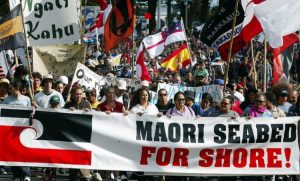Biographical Timeline | Leadership Qualities | N.Z. Foreshore and Seabed References
Our Current Event is the New Zealand Foreshore and Seabed Controversy. This controversy between the New Zealand Government and the Maori Peoples has been ongoing since 1840 when the Treaty of Waitangi was signed. In the treaty it states that the New Zealand Government owns the coastal water, the foreshore and riverbeds. Since the government did legally own the land because of this treaty, they had the authority to grant parts of the foreshore and seabed to whomever they chose. This allowed the foreshore and seabed to be used by the public from these owners.
Now the foreshore and seabed were granted to private owners who allowed the general public to fish and put their boats on the coast. What the New Zealand government forgot to recognize was the Native Maori Peoples rights and use of the land and water. The Maori fish, collect seaweed and used canoes as a form of transportation. Not only is the foreshore and seabed a piece of Maori ways of life, it is apart of their culture. The land under the water was used for canoe landing, as battlegrounds and burial grounds. The government failed to establish an agreement with the Maori and allowed others to use the land without Maori permission.
As a result, the Maori started the battle of earning rights to the foreshore and seabed that holds cultural meaning to them. In the year 1997, Maori from the Marlborough Sounds applied to the Maori Land Court for rights of foreshore and and seabed in the area as Maori customary land. The case went to Court of Appeal but prior to that, the Foreshore and Seabed Act of 2004 was passed. The act claimed that the government is the owner of the foreshore and seabed (excluding private land), the public has access to the the foreshore for recreational purposes and seabeds for navigating boats. What the act also stated was people who owned dry land next to the foreshore since 1840, can apply to the government to redress and could claim territory customary rights.

On March 4th, 2009 at the Ministerial Review Panel the 2004 Foreshore and Seabed Act is being reviewed. The National Party and Maori Party entered into a Relationship and Confidence and Supply Agreement in November 2008. When asked why the 2004 Foreshore and Seabed act was being reviewed the response is stated in the article, Door Open to Repeal of Foreshore and Seabed Act, “In this agreement both parties agreed to initiate a review of the Foreshore and Seabed Act as a priority. A key part of the agreement was recognition of the concerns over the current Act, and also the interests of the public in using the coastal marine area.”
Upon this Ministerial Review Panel in 2009, Prime Minister John Key announced his plans to repeal the 2004 Foreshore and Seabed Act. Mr Key stated these decisions, 2004 Foreshore and Seabed Act would be repealed and replaced with new legislation. The foreshore and seabed currently vested in Crown ownership would be replaced by a public space incapable of being owned; Existing Maori and Pakeha private titles would continue unaffected; and Customary title and customary rights would be recognized through access to justice in a new High Court process or through direct negotiations with the Crown.
In 2011, the 2004 Foreshore and Seabed Act is repealed and replaced with the 2011 Marine and Coastal Area (Takutai Moana) Act of 2011 by the National-led government. The Crown ownership of the foreshore and seabed is replaced with a “no ownership” regime. The Iwi can apply to the court or negotiate with the government for recognition of customary rights or customary marine title over a particular area. These interests cannot prevent existing rights and uses, for example, fishing and public access. As of December 2014, seven applications for recognition and customary rights under the act have been confirmed. However; none have been confirmed as of 2014.

Our Indigenous Leader, Whina Cooper would be an active leader in this current event. Through her lifetime of protesting and marching and fighting for Maori land rights, she would be an active participant in this controversy. Her main involvement in this controversy would be staying involved in the several marches held by other Maori peoples. Just like she was quick to be apart of the Maori Land March of 1975, she would be one of the main faces of the Foreshore and Seabed marches. Upon being involved in marches, Cooper would become involved in the government and Maori party. She would be one of the Maori Natives fighting for the Foreshore and Seabed Act of 2004 to be reviewed and repealed.
